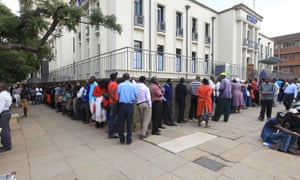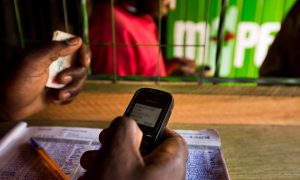The well-known mobile money platform may not choose to commandeer this observation as a marketing slogan, but it does capture some of the reasons why M-Pesa is starting to shift Kenyans away from using cash.
M-Pesa – which references the Swahili word for money – offers efficiency and traceability. And if you lose your phone at the end of the night, no one else can access your funds.
But despite the ubiquity and convenience of mobile money “cash is still king” in the country, as the operator behind M-Pesa itself admits.
“As many as eight out of 10 transactions are still cash,” said Stephen Chege, director of corporate affairs at the market-dominating mobile operator Safaricom. “We want to keep on reducing that ratio.”
M-Pesa and other competitor platforms that have slowly emerged may offer certain solutions to a cash-free daily life. Digital options are the preferred way of paying utility bills – previously an arduous in-person experience at branch offices – and also of sending money to relatives living in rural areas.
But some Kenyans just aren’t ready to give up on the country’s shilling notes and coins.
“I have an M-Pesa service for my customers to buy things, but very few people use it,” said Jane Omondi, who sells vegetables on the side of the road in Kibera, a sprawling, low-income area of Nairobi. “Most of my customers prefer cash payments.”
The reasons for this vary.
Transactions using M-Pesa require multiple, if brief, steps – it’s not uncommon to spot an occasional eye-roll in the supermarket when someone ahead in the queue pulls out their phone to pay.
High transaction fees also put off some users, particularly at the lower end of the market.
In late 2016 Safaricom removed fees for transactions under Ksh100 (£0.71) with a view to driving uptake among the cost-conscious. The response was swift – low-level transactions jumped from 1% of the total volume to nearly 11% by the end of 2017.
As banks and other operators offer alternative mobile money and digital payment platforms, many hope competition will further drive down customer costs.
Perhaps most importantly, many people – especially those who work in the informal sector – are still paid in cash. Even if people transact using mobile money, the funds often begin in physical form.
“We estimate that only about 10% of people’s income is born digitally. So it’s an extra step to move money into the digital environment,” said Tamara Cook, digital innovations head at FSD Kenya, which works to extend financial inclusion.
“We won’t see a big shift until more people are paid digitally.”
A big shift is exactly what has taken place in Zimbabwe, showing how swiftly populations can move away from cash.
Despite its rocky monetary history the country has seen a momentous and rapid shift into digital transactions, the surprising consequence of a new economic crisis.
“We were literally forced into a change of behaviour,” said Dr Lance Mambondiani, CEO of Steward Bank, a retail-focused subsidiary of the country’s leading mobile operator, Econet. “In June 2017 we were averaging 10m transactions per month on our electronic platforms; by November 2017 we had reached 18m per month.”

Zimbabwe abandoned its currency in 2009 after one of the most extreme episodes of hyperinflation in history, adopting the US dollar in its place.
But for the past two years the country has experienced an acute, ongoing shortage of greenbacks.
There are so few US dollars in circulation that Zimbabweans were queuing for hours on end just to withdraw the low daily maximum from their bank accounts. Waiting for change in a cafe can often be a fruitless exercise.
A few months, however, saw a rapid decline in the use of cash. The central bank massively reduced the cost of electronic transactions. Financial institutions and mobile operators raced to offer, or improve, digital solutions.
“Previously only about 20% of transactions were being done electronically, and the remaining 80% was cash,” added Mambondiani. “But by 2017 the surge in electronic transactions saw that share rise to 80%, while cash just accounted for 20% of transactions. It was driven by necessity, there was no other option.”
The uptake of mobile money and swipe cards, as debit-style cards are referred to by Zimbabweans, has progressed at such velocity that the team at Steward Bank admitted that for a period their systems couldn’t process the transactions quickly enough.
The circumstances that have driven Zimbabwe’s fast-paced flight from cash are unusual and unique but reflect the huge growth potential of cash-free transactions in markets across Africa.
There is, however, still a long way to go before many of these markets become cash-light let alone cash-free.
With additional reporting by Asha Jaffar



